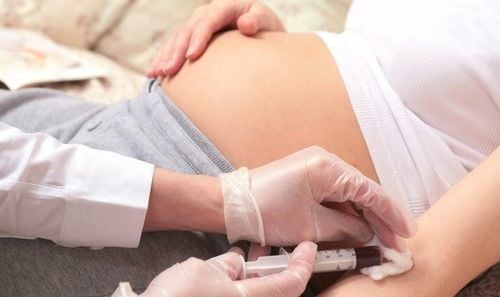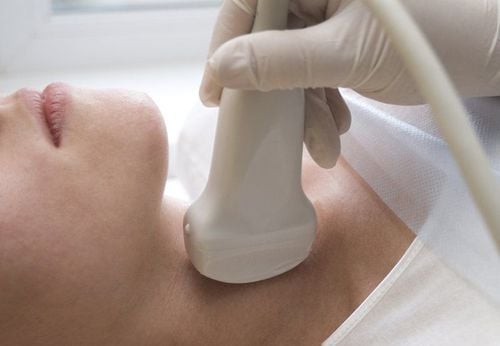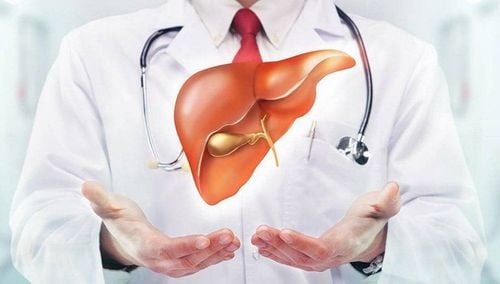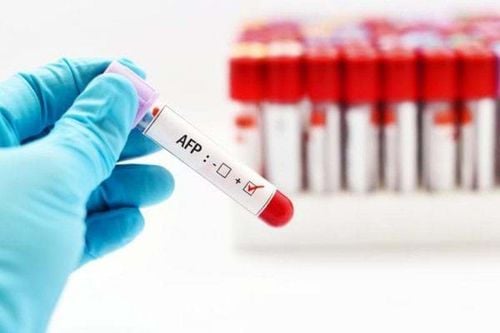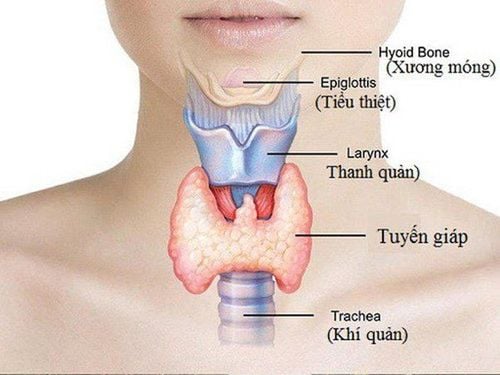This is an automatically translated article.
The article was written by MSc Nguyen Thi Hang - Laboratory Doctor, Laboratory Department - Vinmec Times City International General HospitalYou may need to be checked to see if your thyroid nodule is cancerous. This thyroid nodule can be discovered by you yourself, or by your doctor during an exam or other tests.
1. What is thyroid fine needle aspiration?
Thyroid fine needle aspiration is a procedure to remove a small sample of tissue from the thyroid gland. The cells are removed from the body through a small, hollow needle. The specimen is then sent to the pathology laboratory for analysis.The thyroid gland is located in the anterior neck region. It is butterfly-shaped, with two lobes connected by a narrow band of tissue. It is an endocrine gland that secretes thyroid hormone. This hormone has many functions in the human body.
In some cases, hard nodules are formed on the inside of the thyroid gland. You may notice a small bump in the thyroid area. In most cases, thyroid nodules are not dangerous. But in some cases, they can be thyroid cancer. Thyroid fine needle aspiration can take a sample from the thyroid nodule to check for cancer.

2. Why do I need a thyroid needle aspiration?
Researchers don't know exactly what causes most thyroid nodules. Although they are very popular. Some problems with the thyroid gland, like Hashimoto's thyroiditis, can increase the risk that you will have a thyroid nodule. Thyroid nodules are more common in women than in men. Thyroid nodules tend to enlarge during pregnancy. People who receive radiation therapy to the neck are also more likely to develop thyroid nodules. Your risk of developing thyroid nodules or thyroid cancer is increased if a family member has had thyroid nodules or other cancers.Only a small percentage of thyroid nodules undergo malignant transformation. It's important to identify the cause of the cancer as early as possible, so you can start treatment as quickly as possible.
Not everyone with a thyroid nodule needs fine needle aspiration. Your doctor may start with an ultrasound or CT scan of the neck. Sometimes these tests also provide enough information to know if a nodule is cancerous. A blood test for thyroid hormone levels can provide additional helpful information. If your doctor can't say for sure, you'll probably need fine-needle aspiration.
This procedure is less invasive than an open or closed surgical biopsy. These procedures involve a more extensive surgical cut of the skin. Doctors can perform these procedures a lot less often than fine-needle aspiration.
3. What are the risks of thyroid fine needle aspiration?
Thyroid fine needle aspiration is a very safe procedure, but it may carry some mild risks. These risks include:Bleeding at the puncture site Infection Damage to some structures near the thyroid Since most doctors will use ultrasound to guide the procedure, complications This is almost rare.
There is a small percentage of fine needle aspiration that will not indicate with certainty whether the nodule is cancerous. If this happens, you may need to repeat the aspiration test.
4. How will I need to prepare before having the thyroid fine needle aspiration test?
There is very little preparation for the fine needle aspiration test. Ask your doctor if you should stop any medications you're taking before the procedure, such as blood thinners. You will be able to eat and drink normally before the procedure. You will likely need to go to a medical facility to have the procedure done. You can also go home the same day.
5. What happens during the thyroid needle aspiration procedure?
Some people, like children, may need some medicine to help them relax before the procedure. Otherwise, most people won't need this.In some cases, doctors may inject a local anesthetic at the needle puncture site. Because the needle size is so small, this is also usually not necessary.
Doctors can perform aspiration with the help of ultrasound. This machine uses high-frequency ultrasound to provide images of the nucleus. This helps doctors orient the needle precisely to the right lesion. It also helps prevent damage to other structural areas. A gel-like substance will be applied to the neck area, which will be the site of the use of the ultrasound probe.
After cleaning the area, your doctor will insert a thin, fine needle into your thyroid gland. This move can be a little painful. She or he will slowly push the needle deeper into the correct position of the nucleus, then insert the needle a few times.
The needle attached to the cylinder will help aspirate and remove some cells from the punctured thyroid nodule. Once pumped out of the needle, these cells are spread on a slide. Your doctor will probably repeat this procedure a few times so that samples can be taken from different areas of the nucleus. Occasionally, a raised mass in the neck may be all or mainly fluid. This fluid can be removed during aspiration.
After the procedure, the cells will be sent to a pathology laboratory to analyze signs of cancer. At the end of the procedure, you will be given a small bandage to cover the puncture site.
6. What happens after fine needle aspiration?
Most people will be able to return to normal day-to-day activities immediately. You can also remove the bandage after a few hours.The aspiration site of the body is slightly painful for one or two immediately after the end of the procedure. You can take some pain relievers if necessary. Follow any special instructions your doctor recommends.
You may have to wait a few days to get test results from the pathology laboratory. Ask your doctors when you can return for the results.
If your thyroid nodule has no cancer cells, you may not need any treatment. Doctors may want to monitor your thyroid nodules, and you may need another aspiration in the future. In some cases, your doctor may recommend thyroid hormone medications. This can sometimes reduce the ability of the nucleus to grow back.
You will probably need surgical treatment if your nucleus pulposus has malignant cells. Fortunately, most thyroid cancers are curable.
Sometimes the pathologist cannot determine with certainty whether a thyroid nodule is cancerous. That's when you get a test result that says "atypical of Undetermined Significance (AUS). In cases like these, doctors may recommend repeat testing or surgery, or one option your doctor may want to do is to test the gene on this cell to see if that's the case. Is there a genetic abnormality?
Sometimes genetic testing for surgery is necessary. For example, if you have a thyroid nodule smaller than 1.5 cm and your fine needle aspiration result is “atypical of undetermined significance” and plan to follow up only with annual ultrasound, then genetic testing can alter your plans and lead you to surgery if your thyroid nodules contain abnormal genes or specific genes commonly associated with thyroid cancer. In this case, genetic testing changes the plan from “monitoring” to “surgery.”
Conversely, if you are over 50 years old and have a 4cm nodule, abnormal angiogenesis and fine needle aspiration results of your thyroid nodule being “atypical of undetermined significance”, then the test Genes may not be necessary because surgery may have been suggested for a variety of reasons including: sonographic features, large nuclei, advanced age.
In this case, genetic testing of this nodule would be beneficial only in the context of both the surgeon and the patient intending to perform a total thyroidectomy based on this adjunct information (instead of for indications for thyroidectomy).
Regardless of your test results, you should discuss this with your doctor to find the best possible treatment option for you.
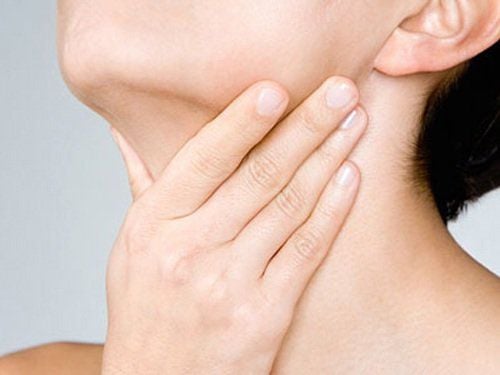
7. Next Steps
Before you agree to the procedure, you need to be sure to know:What is the name of the type of test or procedure done to you? Why you should have this procedure or test What are the expected results and what they mean Risks and benefits of the test or procedure What are the possible side effects or complications Who will be the person doing the test or procedure and their qualifications What happens if you don't have the test or procedure Is there an alternative test or procedure When and how you will get the test results Who to call after the procedure is done if you have any questions or problems How much will it cost you for the test or procedure
8. Genetic testing for thyroid nodules: Veracyte/Afirma, Asuragen, and Thyroseg
There are three commercially available gene tests for thyroid nodules: Veracyte (Afirma), Asuragen, and Thyroseq. They are similar, but each has its own unique advantages. Usually, your doctor will send an FNA sample for one of these three tests. Here are some special things about thyroid gene testing:The Veracyte/Afirma test is most likely to tell you whether the fine needle aspiration cytology sample is benign. This is a “exclusion” test. It is very good to indicate that the thyroid nodule is benign. If this test result tells you the aspiration sample is benign, then the chance of it being cancerous is less than 4%. The Asuragen and Thyroseq tests are both tests that look for abnormal genes associated with thyroid cancer. They look for specific genetic alterations that can help make the diagnosis of thyroid cancer closer, and in some contexts also play a role in determining the best surgical approach for cancer.
Please dial HOTLINE for more information or register for an appointment HERE. Download MyVinmec app to make appointments faster and to manage your bookings easily.
The article references the source: hopkinsmedicine.org, thyroidcancer.com




